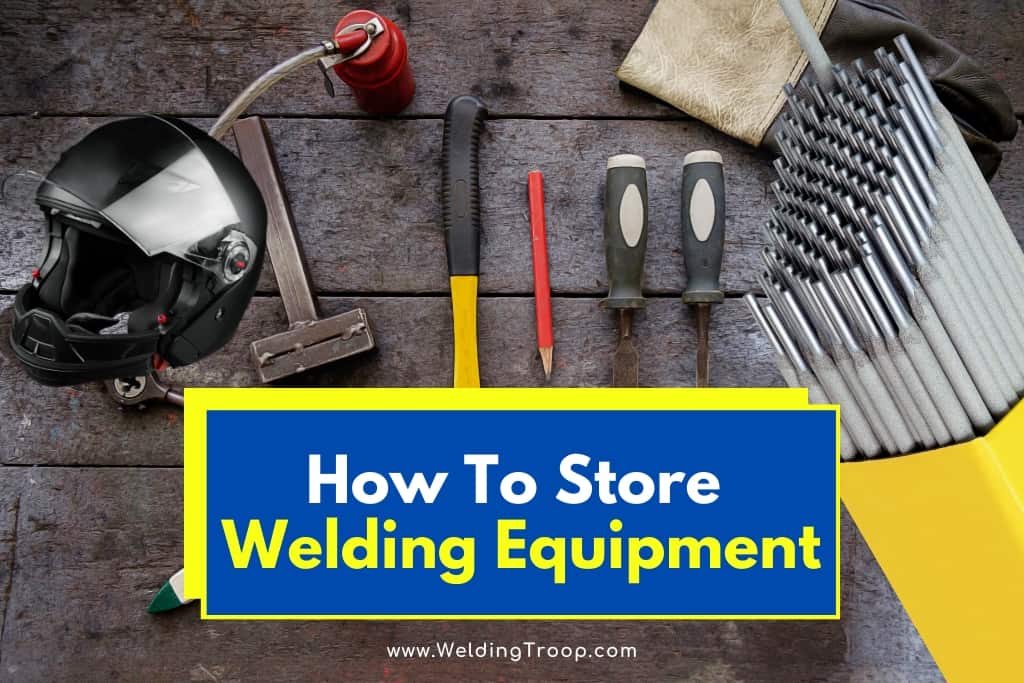You may have welding technique nailed down to a tee, but you will come away disappointed in the quality of your work if you do not store your equipment properly. Here you will find a comprehensive guide on how to properly store your welding equipment.
What is the right way to store welding equipment? Storing welding equipment properly includes the practice of shielding essential gear from the elements of the work environment. Storage efforts should include a plan to keep welding equipment clean and dry. Consumables should be exposed to air as little as possible. Here are some basics examples on how you can properly store your welding equipment:
| Tip-Nr. | Welding Equipment |
|---|---|
| 1 | Welding machine |
| 2 | Gas cylinders |
| 3 | MIG consumables |
| 4 | Hoses and cables |
| 5 | Store welding helmets |
| 6 | Welding clothing |
| 7 | Welding gloves |
In this guide, you will find sections on how to store welding equipment, how to store welding clothes, and how to store welding electrodes. If you are a traveling welder, you will find the section on how to organize your truck particularly applicable.
Table of Contents
How to Store Welding Equipment
Welding equipment includes the welding machines, hoses, cables, gas cylinders, and other attachments. The proper storage of this equipment is essential to the performance of your operation. Storage activities should include efforts to keep the equipment from taking on excess dirt, debris, and moisture. Engaging in proper storage techniques will extend the lifespan of your welding equipment to a significant degree.
How to Store Welders
The time may come periodically when you need to find a place to store your welder or welding machine itself. There is a way to properly store your welder that will prevent it from taking on dust and debris while it sits in the corner.
Pick out an area in the shop for the welder where it will not be disturbed or potentially knocked over by accident. Make sure that all the dials are turned off or turned to zero and that cables and hoses have been removed. Then cover the machine with a small blanket or tarp to keep dust from accumulating in the machine while it sits.
How to Safely Store Gas Cylinders for Welding
The proper storage of gas cylinders is of absolute necessity for keeping your workspace safe. It also ensures that your welding equipment will continue to run smoothly. Care must be taken to make sure that cylinders are still able to regulate pressure after being stowed away for an extended period of time.
In order to keep your workspace safe, take these steps:
- Close the valve every time you are finished with your work
- Never attempt to move the gas cylinders without first making sure that the valves have been closed
- Keep Oxygen cylinders and acetylene cylinders at least 20 feet apart or separated by a firewall
- Keep cylinders as far as practical from fire, hot slag, and flame
All of the regulators, hoses, and other such components need to be stored in dry, clean, and well-ventilated space when they are not in use. Excess moisture can potentially lead to the rusting of the metal components of the gas delivery system.
Storing MIG Consumables
Metal Inert Gas (MIG) consumables the weld gun, the contact tips, nozzles, liners, and gas diffusers. These parts must be properly stored in order to prevent damage from dust, debris, moisture, and oils found in the workshop.
If dust, debris, and other potential contaminants are allowed to enter the weld gun assembly, then the strength of the weld itself can become compromised. You should also be cognizant of the level of humidity in the shop. In many areas, this is not a huge concern much of the year, but the humid climate of the Southern United States does warrant extra attention.
Storing MIG Welding Guns
Never leave MIG guns and consumables lying flat on the table, especially between workdays. Welding operators often take steps that they feel will protect the MIG gun from damage. Sometimes the efforts taken to protect the MIG consumables can actually cause unintended damage to the components.
There are a couple of common mistakes made while trying to protect MIG consumables:
- Placing the MIG gun firmly within a tube when it is not being used
- This step damages the MIG gun assembly by nicking the nozzle
- Hanging the MIG gun by its trigger
- This causes the trigger to become less responsive to the welding operator
Here’s how to properly store the MIG Weld Guns:
- Coil the MIG gun and coil into a small loop
- Use a weld gun hanger or holder when possible
- Make sure that the weld gun is hanging from near the handle and that the gooseneck of the gun assembly is pointing upwards rather than downwards
Before you continue reading, here is an article we wrote about How to Increase MIG Welder Life Expectancy
How to Store Contact Tips
The contact tip is the part of the MIG welding assembly that is responsible for transferring the current to the electrode wire. It is a part that can be replaced easily and cheaply. However, the contact tip is a component that needs to be cared for so that the integrity of the weld is not compromised.
One way to take good care of the contact tip is to keep it in its original package until you need it, staving off wear and tear that may be microscopic. You can further support the integrity of the product by placing it within an airtight plastic bag, still keeping it within the original package while it is in the original container.
How to Store MIG Nozzles
The nozzle is the portion of the MIG assembly that is responsible for directing the weld puddle and protecting the contact tip from the molten metal in the weld pool. The proper storage of the MIG nozzle is essential for control over the weld direction.
It is suggested that you store the MIG nozzle in much the same way that you would also store the contact tip. Be sure to keep the nozzle firmly placed within the original package for as long as you can. If you must remove the nozzle from the packaging prior to use, then it is recommended that you at least store the contact tip within an airtight plastic bag.
Related reading: What Are Metal Welding Nozzles Made Of? | Understanding MIG Welding Nozzles
Where Should I Store Excess Hoses/Cable Lead?
The welding cable is the electrical conductor for the welder current. If stored improperly, the cable leads for your welder will begin malfunctioning. In the absolute worst-case scenario, they will become a safety hazard, as was the case with one farmer who was electrocuted after being observed using cables that were un-insulated.
Though the case of the farmer being electrocuted is more an example of blatant negligence than anything else, the story does serve as a stark reminder of the hazards posed by welding machines that are not properly cared for. Both cables and hoses should be stored in a manner where they are loosely-coiled.
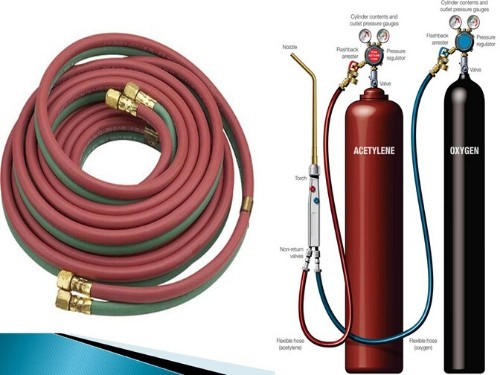
The reasoning behind the loose cooling of the cable is to prevent it from becoming strained. Even little nicks and rubs can become a safety hazard, as stated by OSHA. Small sections of worn cable can also be repaired with electrical or rubber insulation tape. Still, these types of repairs signal that the cable is coming to the end of its lifetime, perhaps prematurely.
You can keep your welding cables and hoses from fraying by wrapping them around a hose wheel. In the alternative, you may consider wrapping the cables carefully by hand and hanging them from a shop hook when they are not in use.
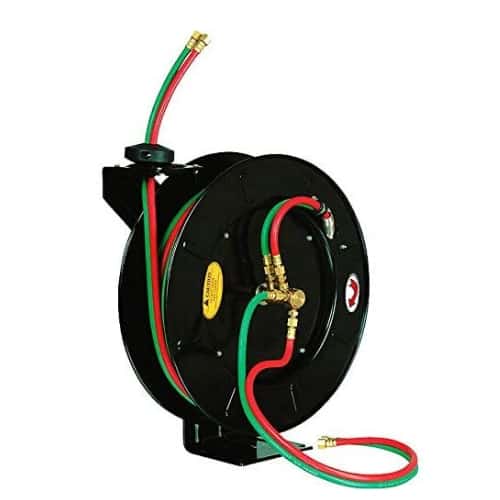
The hose wheel is often preferable to using a utility hook because it allows you to easily transport your cables from one location to the next without much fuss. It cannot be said enough how handy this little wheel is when you have to bring your welding equipment to a site outside the confines of your shop.
Related reading: When Welding, What Color is the Oxygen Hose?
Where Do I Store My Welding Helmet?
It’s a common habit for welders to set aside their welding helmets on the top of their workbench at the end of the day or to stow their safety glasses on the dash of their truck between jobs. Proper welding helmet care calls for a greater effort to store the helmets in a location where they will not accumulate rapid wear and tear.
A quality welding helmet can come at a high cost, be sure to store your helmet(s) locations where the lenses will not become scuffed up. Welding helmet bags come in a variety of types and at a diverse range of price ranges.
The most affordable option is drawstring pouches such as this helmet backpack. At the other end of the spectrum are gear packs such as this one that offer multiple separate pouches for all of your protective welding equipment.
Any kind of a backpack or gear pack is certainly a vast improvement over leaving your welding helmet on a workbench or on the floor or dash of your work truck. The gear packs are an excellent option for mobile welders who spend most of their days traveling from site to site.
You can also find protective cases for safety glasses, including cases with a protective felt lining on the inside. It’s far too easy to scuff up and scratch safety glasses. A quality protective case will extend the lifetime of your safety glasses or goggles so that you do not find yourself continuously replacing them with new pairs.
Welding Clothing Storage
You are encouraged to designate a spot in your shop where you can store all your protective clothing, including gloves, welding jackets, welding aprons, and overalls. This should prevent you from losing track of protective clothing.
You will also probably want to avoid taking your welding gear home with you too often as the clothing may harbor some noticeable and sometimes unpleasant fumes. Storing all your welding clothing in a proper manner should help prevent unnecessary wear and tear resulting from wrinkling. Being organized will also make you look more professional.
Aprons, jackets, coveralls, and other articles of clothing should be hung from hooks at the designated location. You might consider getting a wall-mounted coat rack for your welding shop or mounting a horizontal pole that you can place clothes hangers-on.
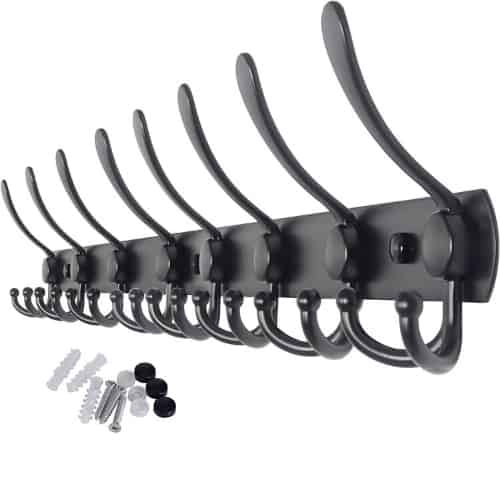
Storing Welding Gloves
Welding gloves must be kept dry. Otherwise, they will lose their ability to protect your skin from the intense heat, as well as the UV and infrared radiation. Water transfers heat better than air, hence the reason while you will also burn yourself if you use a damp or wet oven mitt to pull something out of the oven.
You can hang gloves from a hanger, such as the clothes hanger mentioned in the section above. Another option is to store the gloves within an airtight container such as the Sterlite Underbed Storage Container. You may also store the gloves within a designated drawer in a toolbox.
How to Store Welding Electrodes
The Proper storage location for your welding electrodes will depend upon a variety of factors, including the chemical composition of the electrode, the use of the electrode, and the anticipated lifespan of the electrode.
Stick Electrodes
Stick electrodes include any electrode that is used in shielded metal arc welding (SMAW). The fact that these electrodes are consumables may give you the false impression that storage is not of the utmost concern. Nothing could be further from the truth. Stick electrodes require special care to ensure that they perform as expected.
This is particularly the case with some of the specialty electrodes, such as low hydrogen or cast iron electrodes, that absolutely must be kept dry if you are expecting them to perform as expected. Not all stick electrodes are created equally, either. Recommended storage practices differ amongst electrodes based upon what type of coating the electrode has.
Tig Rod Holder for Welding Table >> Check out the video below
Low Hydrogen Electrodes- Welding Rod Oven
Low hydrogen electrodes include those designated as having a last digit number of 5, 6, or 8 in the American Welding Society (AWS) classification system. As an example, the E7015, E7016, and E7018 electrodes would all be examples of low-hydrogen electrodes.
These electrodes need to be stored in a location where they will be kept dry since they are particularly vulnerable to humidity. Low hydrogen electrodes begin to absorb moisture as soon as you open the package containing the electrodes. Low hydrogen electrodes typically come in either hermetically-sealed cans or vacuum-packed.
The proper storage technique for low hydrogen electrodes involves storing them within an oven that will be kept between 225 and 300 degrees Fahrenheit after the sealed package has been opened, per the instructions of many manufacturers.
You can store opened low hydrogen electrodes in a welding rod oven such as this Keen K-10L Portable Welding Rod Oven. This oven is certainly a worthwhile investment for professional welders. Mild steel electrodes such as the E6010 and E6011 can be stored at air temperature without becoming damaged. Other electrodes, such as cast iron electrodes, for example, do also need to be stored in an oven such as this one.
Are Welding Rod Ovens Worth It?
Welding operators, particularly independent contractors with a small amount of capital, sometimes raise the question of whether a welding rod oven is actually worth it.
The answer to that question really depends upon your use. If you are a DIY/hobbyist welder, then you most likely will not need a welding oven, provided that you do not live in an excessively humid climate. Some types of electrodes are susceptible to damage from moisture.
If you are a professional contractor who routinely uses low hydrogen, stainless steel, or cast iron electrodes, then the welding rod oven will be a worthwhile investment to ensure that stringent performance standards are met. You will also need to consider how quickly you run through packages.
You’d be surprised how quickly low hydrogen electrodes can become damaged in humid environments. If packages of low hydrogen electrodes are opened up, then the best bet to keep them from becoming damaged will be to store them in an oven where they meet the recommended storage temperature requirements.
If these electrodes are not stored in dry and warm conditions, they become subject to various types of damage, including:
- Both internal and external porosity marked by cracks and fissures in the weld
- Under-bead cracking
- Damage that may not be visible to the naked eye
Related reading: What is Hot Start in Welding? Purpose of a hot start welding?
Cast Iron, Stainless Steel
It is recommended that cast iron and stainless steel electrodes also be stored in a welding rod oven in the same manner that low hydrogen electrodes are. The temperature recommendation for cast iron electrodes is 215 to 230 degrees Fahrenheit while the temperature range for stainless steel electrodes is 225 to 260 degrees Fahrenheit.
Fill Freeze Electrodes
The E6012 and E6013 welding rods are included in a class of welding rods called “fill freeze” or “straight polarity” electrodes. For best performance, they should be stored at 100-150 degrees Fahrenheit.
Cellulosic Mild Steel Electrodes
Do not put the “fast freeze mild steel electrodes,” including the E6010 and E6011, in a welding rod oven. If you were to put these electrodes in an oven, you would likely be able to notice a dip in the performance of the electrode. Drying out a cellulosic electrode would lead to excess spatter, porosity, and lack of arc direction at the weld zone.
Mild steel electrodes can be stored in their box within a cool, dry room. For added protection, you can find airtight protective containers such as this Hobart Welding Storage Container.Not only do containers like this keep your electrodes dry, but they are also a great way to keep your shop organized. This particular container is split for four different separated sections. It takes up less space on your desk than four different packages of electrodes would.
Storing MIG Wire Consumables
If MIG wire consumables are not properly stored, they will be susceptible to damage from dust, dirt, and oil. These contaminants can hinder the flow of gas, potentially leading to a noticeable loss of performance. Exposure to excess moisture can lead to the corrosion of MIG consumables.
For this reason, the number one goal of MIG wire storage is to protect the wire from humid conditions. You will see specific instructions on the wire that will specify storage instructions using language like this:
- Temperature 17-27 deg C, relative humidity 60%
Welding rods and spools like MIG wires typically allow for the electrode to be kept outside of the package for two weeks while being exposed to normal workshop conditions. While you are not using the wire, it can be kept in the original packaging as long as it is not exposed to relative humidity greater than the threshold on the packaging.
If your shop is located in either a particularly humid climate or a climate experiencing rapid temperature fluctuations, then you are encouraged to use an airtight container for the wire. The lockable storage bin found here is one such option for an airtight container for welding wires while you are not using them. The storage bin comes in a wide variety of sizes.
Storing Flux Cored Wire
Flux-cored wire electrodes should be stored in a manner that is similar to the way that you would store a MIG wire. Avoid opening the package of electrodes until you are going to use the spool in order to avoid contamination from dirt, oil, and moisture.
You should also store wire in a plastic bag and in an airtight storage container for added insurance. Flux-cored wires are prone to rusting if they are exposed to moisture for an extended period of time. As a result, it is recommended that you take extra precautions to make sure that the wire does not become rusted while still installed within the weld gun.
If you plan on not using the welder for an extended period of time (several days or more), then be sure to remove the wire from the weld gun. This is most important if you live in a humid climate. If the flux-cored wire becomes rusted while it is still in the weld gun, you will end up having to replace the entire welding gun liner.
Related reading: Does Flux Core Wire Go Bad | Tips for Preventing the Effects of Moisture Contamination
Storing TIG Welding Electrodes
Tungsten Inert Gas (TIG) electrodes have similar storage demands to the Many other electrodes. The storage method for TIG electrodes should be one that minimizes exposure to moisture and fluctuations in temperature. Rapid temperature changes can lead to condensation on the electrode.
TIG welding rods are non-consumable, meaning that electrodes are not used up during the welding process. You can find airtight welding riding holders online that will stave off damage from humidity and condensation. Your options include welding rod holders, such as this one that comes in a wide variety of colors to help you organize your TIG welding rod set.
Organizing Your Welding Truck
Many of you may not spend much time in a dedicated welding shop because you are a mobile welder. Keeping your work truck organized is the best way to impress your customers. There is nothing more frustrating than a contractor who arrives on a site and then proceeds to spend a good 30 minutes trying to track down equipment.
Disorganized welders can take a lesson from emergency personnel who must be able to locate life-saving gear in a split second. There are a lot of ways to keep your welding truck organized. You just have to be disciplined enough to create and then follow your own rules.
Get A Utility Box
Many welding trucks are flatbed dually trucks that will have the welding machine mounted right behind the truck cab. There are some who use pickup trucks with a portable welder in the back. Perhaps most effective are the utility trucks with plenty of built-in cargo space.
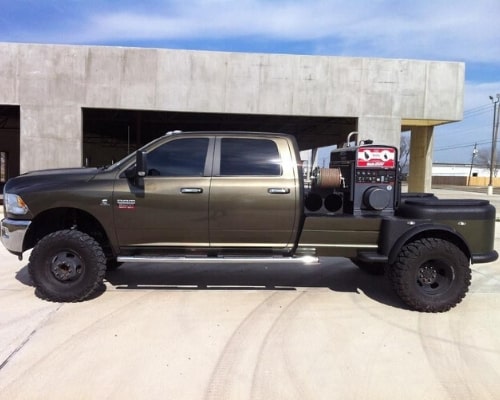
Start off by investing in a quality utility box for your truck, provided that you do not have a utility truck. You can get a utility box added at the dealership, or you can order a gearbox online and install it yourself. One of the most popular utility boxes is the Dee Zee Red Label Utility Chest. This utility chest includes a plastic tray for you to put your smaller tools inside.
Related reading: How Much Does an Average Lincoln Welding Machine Weight?
Label Your Utility Boxes
You may be the owner of a utility truck, or you have multiple utility boxes on the bed of your truck. Either way, we highly recommend labeling all of the boxes. Earlier, we stressed the importance of being able to keep a designated place for each and every item.
These labels certainly don’t have to be anything more advanced than adhesive alphabet letters. This is a common practice for companies with multiple employees, who want to ensure that employees know where all the tools should be put. This practice can be useful for independent contractors as well. It shows your customers that you are well-organized.
Get A Welding Hose Reel
You should also consider getting a spool for your welding hose, such as the Weldcote Materials Manual Hose Wheel. This spool is able to manually collect up to 100 feet of welding hose or cable lead. It is absolutely critical to have this kind of a system in place so that your welding hoses and leads do not begin to take on damage.

